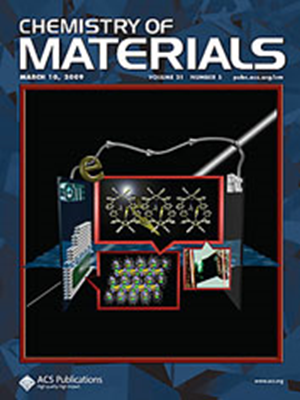为什么在一些绝缘体(包括LK-99)上使用过渡金属添加的电荷定位而不产生金属
IF 7
2区 材料科学
Q2 CHEMISTRY, PHYSICAL
引用次数: 0
摘要
虽然通过掺杂剂向半导体中添加电荷是一种完善的调谐电子特性的方法,但我们证明,在某些绝缘体中引入过渡金属杂质会导致局域电荷,这是由扬-泰勒畸变辅助的。这导致孤立电荷和绝缘材料,而不是紧急状态,包括超导性。我们关注的是添加到Pb10(PO4) 60(“LK-99”)中的Cu杂质,取代了最近文献中讨论的10%的Cu离子。我们的计算表明,即使在标准DFT内,该材料仍然是一个宽带隙绝缘体,在Cu离子上具有孤立的S = 1/2局域电荷──类似于色心,而不需要对Cu d轨道进行电子相关校正。超导性被已知的机制排除在外,这些机制要求材料是金属的。我们解决了先前观察到的密度泛函理论结果与与掺杂位点能量学、晶体结构和透明度相关的实验结果之间的不一致。我们发现,Cu掺杂任何一个Pb位点都会导致CuO4配位和类似的单位细胞体积收缩。掺杂点具有不同局部对称性的工程材料可以诱导非相对论性自旋分裂──通常被称为变磁。然而,在局部电荷的情况下,这可能使自旋被单独控制。本文章由计算机程序翻译,如有差异,请以英文原文为准。

Why Charge Added Using Transition Metals to Some Insulators, Including LK-99, Localizes and Does Not Yield a Metal
While adding charge to semiconductors via dopants is a well-established method for tuning electronic properties, we demonstrate that introducing transition-metal impurities into certain insulators can lead to localized charge, assisted by a Jahn–Teller distortion. This leads to isolated charge and an insulating material, as opposed to emergent states, including superconductivity. We focus on Cu impurities added to Pb10(PO4)6O (“LK-99”), replacing 10% of Cu ions, as discussed in recent literature. Our calculations show that the material remains a wide bandgap insulator with isolated, S = 1/2 localized charges on the Cu ions─similar to color centers, even within standard DFT, without the need for electron correlation corrections to the Cu d-orbitals. Superconductivity is excluded by known mechanisms that require the material to be metallic. We resolve previously observed inconsistencies between density functional theory results and experimental findings related to doping site energetics, crystal structure, and transparency. We find that Cu doping either Pb site leads to CuO4 coordination and a similar unit cell volume contraction. Engineering materials with dopant sites that have different local symmetries can induce nonrelativistic spin splitting─often referred to as altermagnetism. However, in the case of localized charges, this may enable spins to be individually controlled.
求助全文
通过发布文献求助,成功后即可免费获取论文全文。
去求助
来源期刊

Chemistry of Materials
工程技术-材料科学:综合
CiteScore
14.10
自引率
5.80%
发文量
929
审稿时长
1.5 months
期刊介绍:
The journal Chemistry of Materials focuses on publishing original research at the intersection of materials science and chemistry. The studies published in the journal involve chemistry as a prominent component and explore topics such as the design, synthesis, characterization, processing, understanding, and application of functional or potentially functional materials. The journal covers various areas of interest, including inorganic and organic solid-state chemistry, nanomaterials, biomaterials, thin films and polymers, and composite/hybrid materials. The journal particularly seeks papers that highlight the creation or development of innovative materials with novel optical, electrical, magnetic, catalytic, or mechanical properties. It is essential that manuscripts on these topics have a primary focus on the chemistry of materials and represent a significant advancement compared to prior research. Before external reviews are sought, submitted manuscripts undergo a review process by a minimum of two editors to ensure their appropriateness for the journal and the presence of sufficient evidence of a significant advance that will be of broad interest to the materials chemistry community.
 求助内容:
求助内容: 应助结果提醒方式:
应助结果提醒方式:


